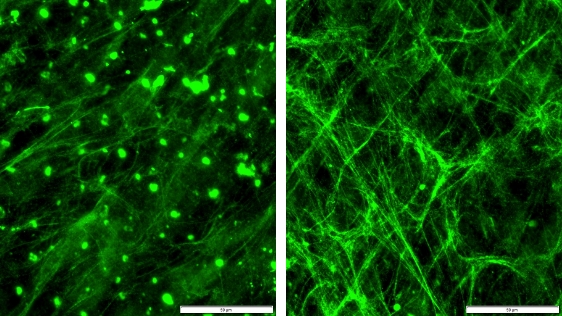
Functional Verification of Materials with Respect to Living Organisms
By investigating the effects of materials on living organisms, we can ensure their safety and create new value that promotes healthy lifestyles.
Safe products are being developed by elucidating the digestion and absorption processes of materials after consumption.
We evaluate the physiological effects of materials on various cells. Through the evaluation, the essential effects on life are clarified and their utility in actual humans is verified through scientific trials before being shared with the world.
Additionally, our experienced research and development professionals assist clients in smoothly responding to regulatory requests, such as applications for functional food claims.

Optical microscope image of cells Cell images show THP-1 cells, differentiated to resemble human macrophages, cultured with only the medium (left) or with the addition of Cryptocyanin O.A. Complex (NK-4), the active ingredient in LUMIN™ A (right).
With the addition of NK-4, cells enlarge and demonstrate extended protrusions, indicating the activation of macrophages.

Antibody fluorescent staining images of cells In skin fibroblasts, glucosylnaringin promotes the formation of elastin fiber (right) versus control (left).
Elastin is a protein that plays a critical role in maintaining skin elasticity by forming fibrous structures to support collagen fibers.
Research and development that respect life
Under the corporate purpose "Respect Life," efforts are being made to adopt new scientific approaches, such as the use of 3D skin models and culture systems that replicate the human intestinal environment, in order to create long-term value without imposing unnecessary burdens on people. We are actively acquiring and accumulating data in order to accurately predict material effects.

In Vitro Human Gut Microbiota Model We implemented an experimental model that simulates the anaerobic environment of the human gut.
Culturing in this model with human feces, for example, allows us to investigate the phenomena that occur within the gut after ingesting materials, as well as the potential health benefits that can result from this process.
By using such models and collecting data, we aim to accurately predict material effects without subjecting humans to testing.

3D Skin Model The 3D skin model showed an increase in Type IV collagen, a key component of the basement membrane (stained black). The basement membrane is essential for keeping the skin healthy.
Recommended Content

Exploring Useful Substances from Nature
Discovering new enzymes from natural samples such as soil.

Manufacturing Utilizing Microorganisms
Using microbiology and cultivation expertise to transform processes from "lab-made" to "mass-produced"

Formulation Design Utilizing Ingredients
We conduct prototyping of food and personal care products to ensure that differences can be felt by people before quantifying product characteristics using instrumental analysis and developing theories about their mechanisms of action.

Contributing to Society Through Our Products and Technologies
We contribute to society through our business activities. Our products and technologies are used to conserve valuable cultural properties.
Inquiries
Please contact us if you have any questions for details about proprietary technologies.
Contact Us